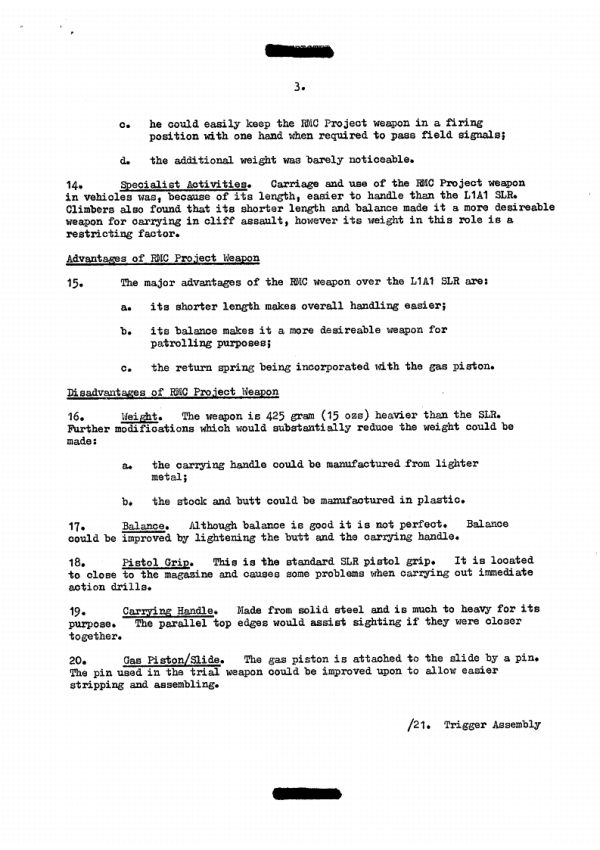The following is a scanned image of a report on the evaluation of the Loughrey rifles by SASR which was subsequently endorsed by the Commanding Officer of the Regiment, LtCol Michael Jeffery. For the convenience of the reader (and for the benefit of search engines) a typed version is also provided:

R1005-1-1
SASR
Campbell Barracks SWANBOURNE WA 6010 9 Mar 76
D Inf
ON TRIALS CONDUCTED ON THE RMC/PROJECT (L1A1 7.62mm MODIFICATION) General 1. In 1970 whist a Cadet at RMC Duntroon, Capt Kevin Loughrey designed and built a weapon designated the RMC/PROJECT L1A1 7.62mm modification. 2. Since 1970, the weapon has been used by many people both in the field and on the range. The weapon is a prototype only, being made out of material that were available at the time. These factors have undoubtedly affectes its performance during the trial. It is important to look on the project wapon not as a finished article, but rather as a new concept, a weapon that could be improved upon to an extent whereby it maintains its length of thirteen inches shorter than the L1A1 SLR, but maintains all the other desireable characteristics of the SLR. 3. The weapon was obtained by SASR from the Infantry Centre for a two month trial period. It was returned to Singleton in Dec 75. Aim 4. The aim of the trial was to assess the suitability of the modified weapon for use by Special Forces and to ascertain if a weapon of its length could maintain the reliability and firepower of the L1A1 7.62mm SLR.. Comparative Characteristics
/2. Conduct of Trial
|
||||||||||||||||||||||||

Conduct of Trial
6. The trial was conducted over a two week period using a total of 15 personnel. Firing practices were held over distances of 25 metres, 100 metres and 300 metres. During all firing practices several L1A1 7.62 SLRs were fired at identical targets.. 7. A three day patrolling exercise was conducted to assess the weapon's suitability for patrol work. It was also carried in vehicels and by climbers. Results of Trial 8. 25 Metre Range Grouping. Little appreciable difference in grouping practices was noticed when fired over 25 metres. 9. 100 Metres Grouping. When fired over 100 metres average groupings were:
12. Instinctive Firing. All firers found the RMC Project weapon superior to the L1A1 SLR for instinctive firing. Accuracy over 25 metres was consistently better by 2-3 inches and the time taken to fire the first ropund was marginally less in most cases. 13. Patrolling. The RMC Project weapons were carried for 3 days on a patrolling exercise. The user reported that:
/c. he could
|
||||||||||||||||||||||||

Advantages of the RMC Project Weapon 15. The major advantages of the RMC weapon over the L1A1 SLR are:
18. Pistol Grip. This is the standard SLR pistol grip. It is located close to the magazine and causes some problems when carrying out immediate action drills. 19. Carrying Handle. Made from solid steel and is much to heavy for its purpose. The parallel top edges would assist sighting if they were closer together. 20. Gas Piston/Slide. The gas piston is attached to the slide by a pin. The pin used in the trial weapon could be improved upon to allow easier stripping and assembling. /21. Trigger Assembly
|
||||||||||||||||||||||||

21. Trigger Assembly. This consists of a trigger on the pistol grip connected by means of a rod along the outside of teh weapon to the trigger housing. The system is cumbersome and requires complete modification. 22. Safety Catches. Two safety catches are used. One should be removed. 23. Magazine Catch. The magazine release catch is awkward to use and requires extending. 24. Butt - Pistol Grip Distance. The distance from the butt to the pistol grip is too long. This could be remedied by either shortening the butt or moving the pistol grip back slightly. The former would be more desireable. 25. Carrying Comfort. This could be increased by the removal of the metal protusions on each side of the rear of the pistol grip. The parallel top edges would assist sighting if they were closer together. 26. Firing Comfort. Discomfort is caused when the cheek is rested against the slide. This is particularly so for left handed firing. Conclusion 27. It is considered that the concept of the RMC Project weapon is a good one. The fact that it is made mostly of L1A1 SLR parts would enable production of a modified version to be undertaken withour a major equipment refitting programme. The majority of the disadvantages of the weapon can be fixed with relative ease. With the disadvantages corrected it is considered that the weapon would be ideal for use by Infantry Battalions and Special Forces units. Recommendation 28. It is recommended that the existing RMC Project weapon be forwarded to ADE for correction of its current design faults and that a number of corrected versions be manufactured by the Infantry Battalions and SASR.
Original Signed By
(P.A. CULLINAN) Capt Trails Officer |
||||||||||||||||||||||||

Comments by CO of Reporting Unit 1. Concur with Trial's Report. 2. It would seem ideal in the parachutist role. 3. I would like its accuracy tested to 600 metres.
Original Signed By (P.M. JEFFERY) Lt Col CO Enclosure: 1. Photographs (2). |